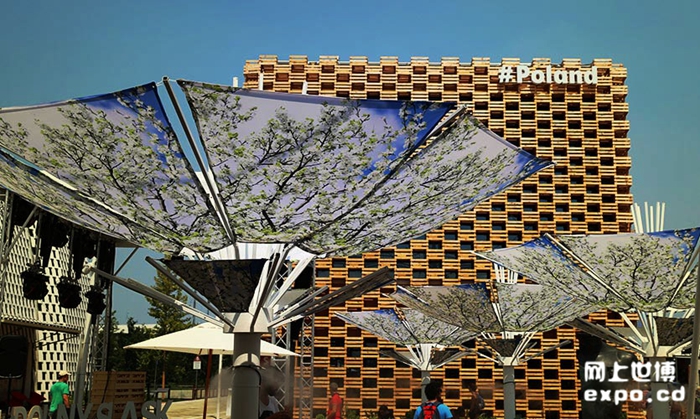
A visit to the Polish Pavilion starts before you even enter the building, thanks to the wooden cloister near the Decumano where you can taste free fresh fruit juices or typical sweetcakes. The rectangular structure is lined by the wooden boxes used to transport apples… this fruit has been chosen as a symbol of the country, which is its leading producer in Europe and number three in the world. The Pavilion’s logo is a hashtag: designed on the pavement outside, it echoes the composition of the apple crates, and expresses Poland’s modern technology as the other side of the coin from its glorious traditions. The “Grande Toscano” statue by Igor Mitoraj, a great Polish sculptor who lived much of his life in Italy, leads the visitor to the entrance.A Garden of Nature and Music: a surprise for visitors
Ascending to the first floor, you are greeted by the notes of a waltz by Wojciech Kilar as you enter the “Magic Garden”, a place where natural vegetation grows next to apple trees. Surrounded by mirrored walls, the path winds its way through various natural herbs and a statue by Igor Mitoraj. The reflection of the apple trees in the mirrors creates the illusion of a huge space, reinforcing the magical atmosphere. Poland’s intention is to highlight its achievement as a fruit producer and also to emphasize its regional varieties, hence the decision to rotate the presence of its 16 regions inside the Pavilion. From this garden you enter a room where, until September, three concerts a day will be devoted to piano recitals of Chopin’s music, executed by young pianists from the Fryderyk Chopin Institute.
A nation abundant with apples and different kinds of amber
The visitor’s route continues by descending to the floor below, where a giant screen shows the special features of Poland’s production and commerce, focusing especially on fruit, cereals, mushrooms and systems for recycling unused food. A well-stocked store offers typical Polish products, from vodka containing tiny flakes of gold to chocolate desserts, and from a wide choice of delicious ciders to amber jewellery products. The Pavilion also houses works by the Polish designer Przemyslaw “Mac” Stopa.
The Chocolate Train, the Mouth of Truth and a souvenir photo.
The attractions of the final room represent the heart of the Pavilion. Firstly visitors remain enchanted by the huge railway model made entirely from chocolate: landscapes, trains and tunnels all created by a Polish sweet manufacturer in 1851. Turning away from this, you are taken by surprise by a huge “Mouth of Truth” projected onto a giant screen. This interacts with visitors, chatting and answering their questions. This area has one zone which changes cyclically, each time playing host to a different region which take turns display the specialties. Such as the region of Lower Silesia, famous for its ancient paper factory, its brightly painted building exteriors, and its fine pottery production. Visitors can try their hand at decorating plates by hand, supervised by teachers, or else choose the mixture of aromatic herbs to make a herbal tea according to their liking or their health requirements.
To round off your visit, you can go to the 3D room, showing an animated video on the history of Poland, or visit the photographic space where you can have your photo taken against a digital backdrop which changes according to the Polish Region of the moment, offering you a free digital copy which, if posted on the social networks, can participate in the final extraction to win the prize of a week’s holiday. On the ground floor of the Pavilion, visitors can relax and eat typical Polish products in a comfortable restaurant space.

